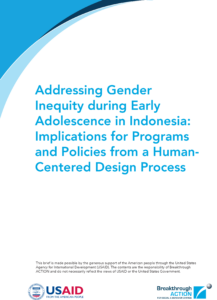To create a truly supportive environment for gender equality among very young adolescents (VYAs), programs must reach the people, systems, and organizations that influence adolescents’ lives, including families, community networks, schools, health systems, civil society, and other government services.[i] These social and structural determinants of gender inequality influence how gender norms, roles, and systems take shape during adolescence and how VYAs navigate power relations and their emerging gender identities during this crucial period—the time between 10 and 14 years of age.
Breakthrough ACTION produced this document, Addressing Gender Inequity during Early Adolescence in Indonesia [ Bahasa Indonesia | English ], to share key learnings from a human-centered design process with VYAs in Indonesia that suggests three key implications for programs and policies:
- Invest in activities that bring families and communities together to address gender norms.
- Intentionally address the intersection of gender and violence among both boys and girls.
- Use a systems approach to create a culture of collaboration between different sectors that shape adolescents’ lived experiences.
VYA Pilot Package
Related Resources
- Creating a Gender-Equitable Environment for Very Young Adolescents: Messages and Evidence to Persuade Decision Makers
- Design & Test Reports from Indonesia and the Democratic Republic of the Congo
- Engaging Parents in Sexual and Reproductive Health: Programs for Very Young Adolescents in the Democratic Republic of the Congo
- Leveraging Human-Centered Design to Improve Gender-Equitable Adolescent Programming in the DRC and Indonesia: Process Brief and Learnings
Reference
[i] George, A. S., Amin, A., de Abreu Lopes, C. M., & Ravindran, T. K. S. (2020). Structural determinants of gender inequality: Why they matter for adolescent girls’ sexual and reproductive health. BMJ, 368, l6985. https://doi.org/10.1136/bmj.l6985


